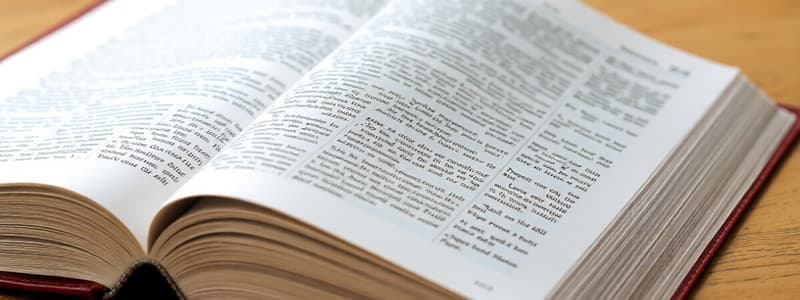Podcast
Questions and Answers
What distinguishes academic reading from recreational reading?
What distinguishes academic reading from recreational reading?
- It requires a more active, probing, and recursive strategy. (correct)
- It involves memorizing facts and figures without critical engagement.
- It requires less concentration and is primarily for leisure.
- It focuses on narrative storytelling rather than factual information.
Which of the following best describes the primary purpose of layers within academic reading?
Which of the following best describes the primary purpose of layers within academic reading?
- To superficially scan the text for basic information.
- To critically analyze relationships within the text and connect it to broader contexts. (correct)
- To memorize key terms and definitions in the text.
- To passively accept the author’s viewpoint without questioning.
What is a defining characteristic of academic texts?
What is a defining characteristic of academic texts?
- They primarily focus on personal opinions and subjective experiences.
- They avoid complex grammatical structures to maintain clarity.
- They are written in informal language to be easily understood.
- They are critical, objective, and specialized, written by experts. (correct)
What is the primary function of supporting sentences within a paragraph?
What is the primary function of supporting sentences within a paragraph?
What is the role of a concluding sentence in a paragraph?
What is the role of a concluding sentence in a paragraph?
In a paragraph structured with a deductive pattern, where is the topic sentence typically found?
In a paragraph structured with a deductive pattern, where is the topic sentence typically found?
In which pattern of paragraph development is the topic sentence not directly stated but suggested through the content?
In which pattern of paragraph development is the topic sentence not directly stated but suggested through the content?
Which pattern do most academic texts follow in their composition?
Which pattern do most academic texts follow in their composition?
What is the primary aim of academic writing?
What is the primary aim of academic writing?
When is it most appropriate to use direct quoting in academic writing?
When is it most appropriate to use direct quoting in academic writing?
According to the provided guidelines, what is a key principle of quoting?
According to the provided guidelines, what is a key principle of quoting?
In APA format, what information is typically included when citing a direct quote?
In APA format, what information is typically included when citing a direct quote?
What is the main difference between parenthetical and narrative citations?
What is the main difference between parenthetical and narrative citations?
What does it mean to paraphrase a source?
What does it mean to paraphrase a source?
When citing a paraphrase in APA style, what elements should be included?
When citing a paraphrase in APA style, what elements should be included?
What is the main purpose of summarizing a text?
What is the main purpose of summarizing a text?
Which of the following is an example of a reporting verb used in summarizing?
Which of the following is an example of a reporting verb used in summarizing?
What is the purpose of referencing in academic writing?
What is the purpose of referencing in academic writing?
According to the rules in referencing, how should an author's name be formatted?
According to the rules in referencing, how should an author's name be formatted?
In the context of writing literature reviews, what does 'identifying themes, debates, and gaps' involve?
In the context of writing literature reviews, what does 'identifying themes, debates, and gaps' involve?
Flashcards
Academic Reading
Academic Reading
A strategic way of reading that involves understanding the topic, finding research materials, and developing ideas.
Layers of Academic Reading
Layers of Academic Reading
Involves questioning, reflecting, interpreting, connecting, and refining to deeply understand a text.
Academic Texts
Academic Texts
Objective, critical, and specialized texts written by experts in a formal style and tone.
Paragraph
Paragraph
Signup and view all the flashcards
Supporting Sentences
Supporting Sentences
Signup and view all the flashcards
Concluding Sentences
Concluding Sentences
Signup and view all the flashcards
Topic Sentence
Topic Sentence
Signup and view all the flashcards
Deductive Pattern
Deductive Pattern
Signup and view all the flashcards
Inductive Pattern
Inductive Pattern
Signup and view all the flashcards
Inductive-Deductive Pattern
Inductive-Deductive Pattern
Signup and view all the flashcards
Hinted Pattern
Hinted Pattern
Signup and view all the flashcards
IBC Pattern
IBC Pattern
Signup and view all the flashcards
ABC Format
ABC Format
Signup and view all the flashcards
Academic Language
Academic Language
Signup and view all the flashcards
Academic Writing
Academic Writing
Signup and view all the flashcards
Academic Text
Academic Text
Signup and view all the flashcards
Direct Quoting
Direct Quoting
Signup and view all the flashcards
Basic Principles of Quoting
Basic Principles of Quoting
Signup and view all the flashcards
Proper APA Format
Proper APA Format
Signup and view all the flashcards
Paraphrasing
Paraphrasing
Signup and view all the flashcards
Study Notes
Academic Reading
- Academic reading differs from everyday reading, requiring a more active, probing, and recursive approach.
- Strategic reading involves understanding your topic, finding research materials, and developing your ideas.
Layers of Academic Reading
- It includes asking questions, reflecting on relationships within the text, interpreting meaning, connecting with other readings, and refining your topic and purpose.
Academic Texts
- These texts are critical, objective, specialized, and written by professionals or experts in a particular field.
- It uses formal language, style, and tone.
- Academic texts may take the form of grammatical units like words, phrases, clauses, and sentences.
Paragraphs
- Paragraphs are sets of related sentences with one main idea in a topic sentence.
- Supporting sentences develop thesis or main idea of paragraph
- Concluding sentences restate or summarize the thesis or main idea.
Topic Sentences
- Paragraphs can present the topic sentence at the beginning or end.
- Topic sentences control the idea, guiding the paragraphs flow and limiting the topic and should be specific and not a fact
Patterns of Paragraph Development
- Deductive pattern: the topic sentence is stated at the beginning.
- Inductive pattern: the topic sentence is stated at the end.
- Deductive-inductive pattern: the topic sentence is stated at the beginning and restated at the end.
- Inductive-deductive pattern: the topic sentence is stated in the middle.
- Hinted pattern: the topic sentence is not stated but implied.
Academic Text Composition Pattern
- Most academic texts follow the IBC pattern: Introduction, Body, Conclusion.
- Technical texts may follow the ABC format: Abstract, Body, Conclusion.
- A preview-view-review (PVR) approach may also be used.
Academic Language
- It encompasses the oral, written, auditory, and visual language proficiency needed for effective learning in academic settings; formal, impersonal, precise, and objective.
- Social language is informal, personal, and may use slang and repetitive language.
Academic Writing
- Academic writing should be clear, concise, focused, structured, and supported by evidence.
- It starts by posing a question, problematizing a concept, or evaluating an opinion, and ends by answering, clarifying, or arguing.
- It aims to inform, argue a point, or persuade.
Academic Text
- Academic text provides information, concepts, and theories related to a specific discipline.
- Characteristics include complexity, evidence-based arguments, a thesis-driven approach, academic language, and structure.
Direct Quoting
- Copying someone else's words and crediting the source.
When to use quotes
- Use it when focusing on language, giving evidence, and presenting the author's position or definition.
- Critically use direct quotes when it comes to supporting your argument
Basic Principles of Quoting
- Enclose the quoted text in quotation marks/formatted as a block quote.
- Correctly cite the original author.
- Ensure the text is identical to the original.
Proper APA Format in Citing a Quote
- include author's last name, year, page.
- Use "p" for a single page and "pp" for a page range.
- Use a parenthetical or narrative citation.
Ways to Introduce a Quote
- Use introductory sentences or signal phrases.
- Integrate the quote into your sentence.
Other Guidelines in Formatting a Direct Quote
-
Shorten a quote using ellipsis (...).
-
Add information using square brackets [].
-
indicate an original error using [sic] in italics.
-
Format block quotations if the quote is more than 40 words.
Paraphrasing
- Paraphrasing puts someone else's ideas into own words without changing the meaning.
Basic Principles of Paraphrasing
- Writing the text in your own words.
- Make sure the text did not change.
- The source is cited according to APA in-text citation rules.
Paraphrasing in 5 steps
- Read the passage and note key concepts
- Cite the source
Citing a Paraphrase
- In APA style, include the author's last name, year of publication, and page or paragraph numbers.
Summarizing With Basic In-Text Citation
- Summarizing is the brief restatement of a text's main points and selecting key features to create a shorter version
Summarizing Formats
- Author heading format: summarized idea after citation.
- Idea heading format: summarized idea before citation.
- Date heading format: summarized idea after the date.
Using Reporting Verbs in Summarizing
- Reporting verbs discuss another person's writings or assertions integrating the source in the text.
Techniques in Summarizing
- Read the word first to understand the author's intent
- Summaries should start by identifying the main ideas and ensuring a smooth flow
- Use only a few sentences to limit the summary
- Proofread your work.
Referencing in APA Format
- Referencing acknowledges and cites sources.
- Provide detailed information for readers to locate original materials.
Purposes of Referencing
-
Acknowledge the sources
-
Avoid plagiarism
-
Provides validation
-
Establishes Contextualization
-
Upholds academic standards, promote intellectual honesty, and promote the exchange of knowledge with other universities.
Rules in Referencing
- Author: last name, initials.
- Date: after the author's name.
- Title: capitalize the first word.
- Source: should be capitalized including details
APA Reference Rule for Various Materials
- The text details how to reference different materials like books, chapters, journals, and online articles, following APA guidelines.
Review of Related Literature (RRLs)
- It's the analysis of existing scholarly sources relevant to a topic or question.
Purpose of Review of Related Literature
- Provides context to the study
- Identifies any gaps in the literature
- Synthesizing findings from various sources
- Critically evaluating previous studies
Writing Literature Reviews
- Search reliable sources, evaluate their relevance, and identify themes, debates, and gaps.
- Structure the review chronologically, thematically, methodologically, or theoretically.
Writing the Introduction, Body, and Conclusion
-
Introduction: The focus and restates the key points
-
Body: should be dived into subsections
-
Summarize, synthesize, evaluate, and structure paragraphs in the main body which contributes new knowledge.
Three Ways in Explaining a Concept
- Definition: clarifying a term's meaning. Explication: interpreting a text's meaning in detail.
- Clarification: organizing ideas from general to specific with examples.
Identifying Themes, Debates, and Gaps
- Identify trends in the literature and examine relevant or reoccurring themes
- Identify conflicts of interest and studies that have changed the direction of the field.
- Identify any gaps that need to be addressed in a literature.
Writing the Methodology
- Explain the approach used whether it's qualitative or quantitative.
- Describe the methods of data collection to provide the tools
- Evaluate justify how any choices will contribute to the new knowledge.
Studying That Suits You
Use AI to generate personalized quizzes and flashcards to suit your learning preferences.




